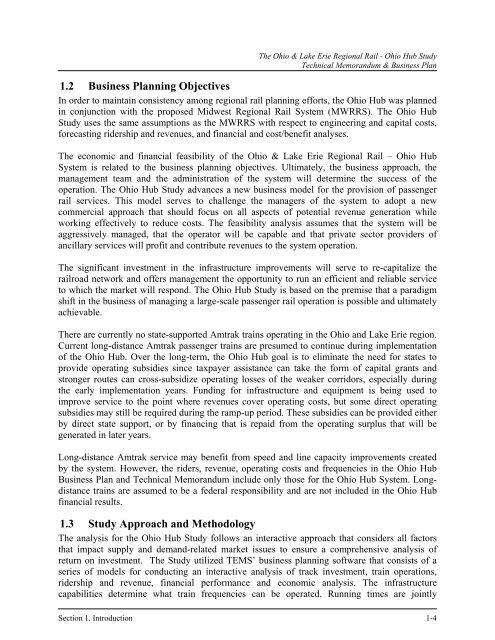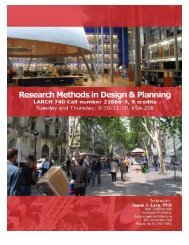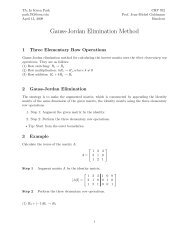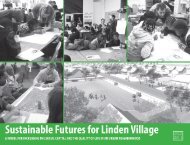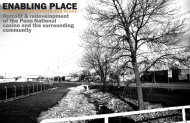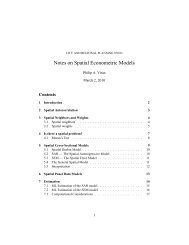Link to 3C Final Report - The Ohio State University
Link to 3C Final Report - The Ohio State University
Link to 3C Final Report - The Ohio State University
Create successful ePaper yourself
Turn your PDF publications into a flip-book with our unique Google optimized e-Paper software.
<strong>The</strong> <strong>Ohio</strong> & Lake Erie Regional Rail - <strong>Ohio</strong> Hub Study<br />
Technical Memorandum & Business Plan<br />
1.2 Business Planning Objectives<br />
In order <strong>to</strong> maintain consistency among regional rail planning efforts, the <strong>Ohio</strong> Hub was planned<br />
in conjunction with the proposed Midwest Regional Rail System (MWRRS). <strong>The</strong> <strong>Ohio</strong> Hub<br />
Study uses the same assumptions as the MWRRS with respect <strong>to</strong> engineering and capital costs,<br />
forecasting ridership and revenues, and financial and cost/benefit analyses.<br />
<strong>The</strong> economic and financial feasibility of the <strong>Ohio</strong> & Lake Erie Regional Rail – <strong>Ohio</strong> Hub<br />
System is related <strong>to</strong> the business planning objectives. Ultimately, the business approach, the<br />
management team and the administration of the system will determine the success of the<br />
operation. <strong>The</strong> <strong>Ohio</strong> Hub Study advances a new business model for the provision of passenger<br />
rail services. This model serves <strong>to</strong> challenge the managers of the system <strong>to</strong> adopt a new<br />
commercial approach that should focus on all aspects of potential revenue generation while<br />
working effectively <strong>to</strong> reduce costs. <strong>The</strong> feasibility analysis assumes that the system will be<br />
aggressively managed, that the opera<strong>to</strong>r will be capable and that private sec<strong>to</strong>r providers of<br />
ancillary services will profit and contribute revenues <strong>to</strong> the system operation.<br />
<strong>The</strong> significant investment in the infrastructure improvements will serve <strong>to</strong> re-capitalize the<br />
railroad network and offers management the opportunity <strong>to</strong> run an efficient and reliable service<br />
<strong>to</strong> which the market will respond. <strong>The</strong> <strong>Ohio</strong> Hub Study is based on the premise that a paradigm<br />
shift in the business of managing a large-scale passenger rail operation is possible and ultimately<br />
achievable.<br />
<strong>The</strong>re are currently no state-supported Amtrak trains operating in the <strong>Ohio</strong> and Lake Erie region.<br />
Current long-distance Amtrak passenger trains are presumed <strong>to</strong> continue during implementation<br />
of the <strong>Ohio</strong> Hub. Over the long-term, the <strong>Ohio</strong> Hub goal is <strong>to</strong> eliminate the need for states <strong>to</strong><br />
provide operating subsidies since taxpayer assistance can take the form of capital grants and<br />
stronger routes can cross-subsidize operating losses of the weaker corridors, especially during<br />
the early implementation years. Funding for infrastructure and equipment is being used <strong>to</strong><br />
improve service <strong>to</strong> the point where revenues cover operating costs, but some direct operating<br />
subsidies may still be required during the ramp-up period. <strong>The</strong>se subsidies can be provided either<br />
by direct state support, or by financing that is repaid from the operating surplus that will be<br />
generated in later years.<br />
Long-distance Amtrak service may benefit from speed and line capacity improvements created<br />
by the system. However, the riders, revenue, operating costs and frequencies in the <strong>Ohio</strong> Hub<br />
Business Plan and Technical Memorandum include only those for the <strong>Ohio</strong> Hub System. Longdistance<br />
trains are assumed <strong>to</strong> be a federal responsibility and are not included in the <strong>Ohio</strong> Hub<br />
financial results.<br />
1.3 Study Approach and Methodology<br />
<strong>The</strong> analysis for the <strong>Ohio</strong> Hub Study follows an interactive approach that considers all fac<strong>to</strong>rs<br />
that impact supply and demand-related market issues <strong>to</strong> ensure a comprehensive analysis of<br />
return on investment. <strong>The</strong> Study utilized TEMS’ business planning software that consists of a<br />
series of models for conducting an interactive analysis of track investment, train operations,<br />
ridership and revenue, financial performance and economic analysis. <strong>The</strong> infrastructure<br />
capabilities determine what train frequencies can be operated. Running times are jointly<br />
Section 1. Introduction 1-4


